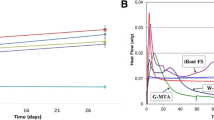Abstract
This study explores water sorption, hygroscopic expansion, mechanical strength and ion release from the experimental amorphous calcium phosphate (ACP) composites formulated for application as endodontic sealers. Light-cure (LC) and dual-cure (DC; combined light and chemical cure) resins comprised urethane dimethacrylate (UDMA), 2-hydroxyethyl methacrylate (HEMA), methacryloyloxyethyl phthalate (MEP) and a high molecular mass oligomeric co-monomer, poly(ethyleneglycol)-extended UDMA (PEG-U) (designated UPHM resin). To fabricate composites, a mass fraction of 60% UPHM resin was blended with a mass fraction of 40% as-made (am-) or ground (g-) ACP. Glass-filled composites were used as controls. Both DC and LC ACP UPHM composites exhibited relatively high levels of water sorption accompanied by a significant hygroscopic expansion. The latter may potentially be useful to offset high polymerization stresses that develop in these materials. Ion release profiles of the experimental materials confirmed their potential for regeneration of mineral-deficient tooth structures. Their moderate to low mechanical strength after 3 months of aqueous immersion did not diminish the enthusiasm for the proposed use as endodontic sealers. For that application, DC g-ACP composites appear to be the most adequate, but micro-leakage and quantitative leachability studies are needed to fully establish their suitability.







Similar content being viewed by others
References
Dorozhkin SV. Calcium orthophosphates in nature, biology and medicine. Materials. 2009;2:399–498.
Boskey AL. Amorphous calcium phosphate. The contention of bone. J Dent Res. 1997;76:1433–6.
Eanes ED. Amorphous calcium phosphate: termodynamic and kinetic considerations. In: Amjad Z, editor. Calcium phosphates in biological and industrial systems. Boston: Kluwer Academic Publishers; 1998. p. 21–39.
Antonucci JM, Skrtic D. Physicochemical properties of bioactive polymeric composites: effects of resin matrix and the type of amorphous calcium phosphate filler. In: Shalaby DW, Salz U, editors. Polymers for dental and orthopedic applications. Boca Raton: CRC Press; 2007. p. 217–42.
Skrtic D, Antonucci JM. Dental composites based on amorphous calcium phosphate—resin composition/physicochemical properties study. J Biomater Appl. 2007;21:375–93.
Skrtic D, Hailer AW, Takagi S, Antonucci JM, Eanes ED. Quantitative assessment of the efficacy of amorphous calcium phosphate/methacrylate composites in remineralizing caries-like lesions artificially produced in bovine enamel. J Dent Res. 1996;75(9):1679–86.
Langhorst SE, O’Donnell JNR, Skrtic D. In vitro remineralization of enamel by polymeric amorphous calcium phosphate composite: quantitative micro-radiographic study. Dent Mater. 2009;25:884–91.
Skrtic D, Antonucci JM, Eanes ED. Amorphous calcium phosphate-based bioactive polymeric composites for mineralized tissue regeneration. J Res Natl Inst Stand Technol. 2003;108(3):167–82.
Skrtic D, Antonucci JM, Eanes ED, Eidelman N. Dental composites based on hybrid and surface-modified amorphous calcium phosphates—a FTIR microspectroscopic study. Biomaterials. 2004;25:1141–50.
Antonucci JM, Skrtic D. Matrix resin effects on selected physicohemical properties of amorphous calcium phosphate composites. J Bioact Compat Polym. 2005;20:29–49.
Skrtic D, Antonucci JM, Liu DW. Ethoxylated bisphenol A methacrylate-based amorphous calcium phosphate composites. Acta Biomater. 2006;2(1):85–94.
Tung MS, Eichmiller FC. Dental applications of amorphous calcium phosphates. J Clin Dent. 1999;10:1–6.
Reynolds EC, Cai F, Shen P, Walker GD. Retention in plaque and remineralization of enamel lesions by various forms of calcium in a mouthrinse or sugar-free chewing gum. J Dent Res. 2003;82(3):206–11.
Mazzaoui SA, Burrow MF, Tyas MJ, Dashper SG, Eakins D, Reynolds EC. Incorporation of casein phosphopeptide-amorphous calcium phosphate into a glass-ionomer cement. J Dent Res. 2003;82(11):914–8.
Antonucci JM, Skrtic D, Eanes ED. Polymeric amorphous calcium phosphate compositions. U.S. Letters Patent 1996;5,508,342:April 16.
O’Donnell JNR, Skrtic D. Degree of vinyl conversion, polymerization shrinkage and stress development in experimental endodontic composite. J Biomim Biomater Tissue Eng. (in press).
Söderholm KJ, Zigan M, Ragan M, Fischlschweiger W, Bergman M. Hydrolytic degradation of dental composites. J Dent Res. 1984;63:1248–54.
Berglund A, Hulterström AK, Gruffman E, van Dijken JWV. Dimensional change of calcium aluminate cement for posterior restorations in aqueous and dry media. Dent Mater. 2006;22:470–6.
Feilzer AJ, de Gee AJ, Davidson CL. Relaxation of polymerization contraction shear stress by hygroscopic expansion. J Dent Res. 1990;69:36–9.
Attin T, Buchalla W, Kiebassa AM, Hellwig E. Curing shrinkage and volumetric changes of resin-modified glass ionomer restorative materials. Dent Mater. 1995;11:359–62.
Huang C, Tay FR, Cheung GSP, Kei LH, Wei SHY, Pashley DH. Hygroscopic expansion of a compomer and a composite on artificial gap reduction. J Dent. 2002;30:11–9.
Momoi Y, McCabe JF. Hygroscopic expansion of resin based composites during 6 months of water storage. Br Dent J. 1994;176:91–6.
Antilla EJ, Krintila OH, Laurila TK, Lassila LVJ, Vallittu PK, Hernberg RGR. Evaluation of polymerization shrinkage and hygroscopic expansion of fiber-reinforced biocomposites using optical fiber Bragg grating sensors. Dent Mater. 2008;24:1720–7.
ASTM F394-78 (re-approved 1991). Standard test method for biaxial strength (modulus of rupture) of ceramic substrates.
Rüttermann S, Krüger S, Raab WHM, Janda R. Polymerization shrinkage and hygroscopic expansion of contemporary posterior resin-based filling materials—a comparative study. J Dent. 2007;35:806–13.
Wadgaonkar B, Ito S, Svizero N, Elrod D, Foulger S, Rodgers R, et al. Evaluation of the effect of water-uptake on the compendance of dental resins. Biomaterials. 2006;27:3287–94.
Hirashi N, Yiu CKY, King NM, Tay FR, Pashley DH. Chlorhexidine release and water sorption characteristics of chlorhexidine-incorporated hydrophobic/hydrophilic resins. Dent Mater. 2008;24:1391–9.
Acknowledgements
This investigation was supported by Research Grant DE13169-10 from the National Institute of Dental and Craniofacial Research, the National Institute of Standards and Technology and the American Dental Association Foundation. We gratefully acknowledge Esstech, Essington, PA, USA for generously providing the monomers used in this study.
Author information
Authors and Affiliations
Corresponding author
Additional information
Disclaimer: Certain commercial materials and equipment are identified in this work for adequate definition of the experimental procedures. In no instance does such identification imply recommendation or endorsement by the American Dental Association Foundation or the National Institute of Standards and Technology, or that the material and the equipment identified is necessarily the best available for the purpose.
Rights and permissions
About this article
Cite this article
Johns, J.I., O’Donnell, J.N.R. & Skrtic, D. Selected physicochemical properties of the experimental endodontic sealer. J Mater Sci: Mater Med 21, 797–805 (2010). https://doi.org/10.1007/s10856-009-3873-3
Received:
Accepted:
Published:
Issue Date:
DOI: https://doi.org/10.1007/s10856-009-3873-3




